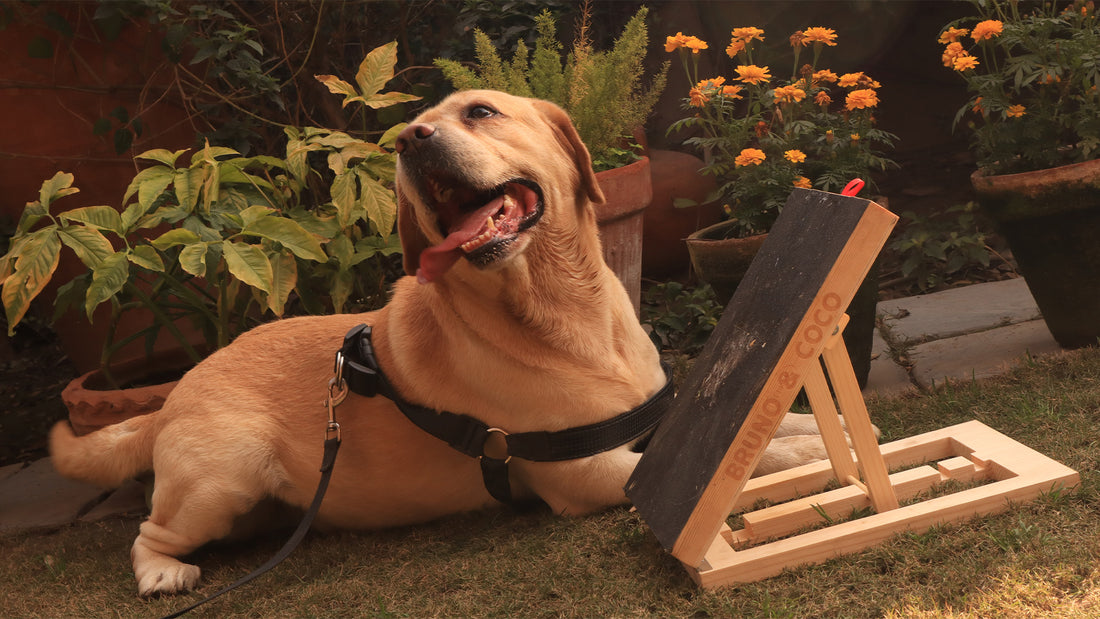
4 Easy Steps to Teach Your Dog to Use a Scratch Pad
Share
Revolutionize your dog's nail care routine with our stress-free solution – the Bruno and Coco Scratch Pad! If traditional clippers or a Dremel raise anxiety levels, this giant nail file for dogs is the game-changer you need. Crafted from robust and durable wood, it features coarse sandpaper securely glued for your dog's safety. Say goodbye to nail trimming worries and hello to a happy pup!

How To Train My Dog To Use a Scratch Pad?
Our product has proven to be effective and durable. For your help & guidance, we provide a training manual with every purchase outlining a step-by-step training process to teach your dog how to use a scratch pad.
The Washcloth Method
- Place the scratch pad on the ground between you & your dog while holding the treat. Show your dog the treat and drape the cloth over the top part of the pad.

- Encourage them to reach across the pad towards you and paw the cloth away to get the treat. Mark and treat each time your dog successfully does this

- Gradually shorten the cloth so it barely covers the treat. We're now gradually removing the cloth from the picture. Continue to mark and treat paw use.

- When your dog reliably paws at the board without the cloth, it's time to start gradually raising your end of it until it's at a 45-degree angle. The steeper, the better.

The Verbal Cue Method
1) Place the scratch pad on the floor, and let your dog sniff and explore it.
2) Now hold a treat in your hand and make sure your dog sees it.
3) Place the treat in the built-in treat box and encourage your dog to get the treat but don't slide it open just yet! Keep your hand on the pad and withhold the treat from your dog, your dog will sniff the treat and eventually paw at it to get the treat out of the box.
4) When your dog paws at the scratch pad, say "scratch", ''file'' or ''yes'' in a loud voice, and release the treat immediately!
5) Repeat the above multiple times till your dog understands what "scratch" means, you can then start to adjust the filing by slightly angling the board to the left or the right, to get all parts of the nails.
Additional Tips:
- Lock the Treat Box: Our product features an in-built treat box with a secure lock, preventing the dog from opening it on their own. This ensures that your dog can't access treats without human assistance, allowing for a controlled way to give them treats.
- Make sure each milestone is rewarded, starting with approaching the scratch pad, to touching it with any body part, then advancing to paw touches, multi-paw touches, and finally, the grand finale of rhythmic scratching.
- Always be generous during training by giving your dog a lot of treats & encouraging verbal cues for any paw movement while they are still learning.
- Place the scratch pad in a spot where your dog spends a lot of time, such as their bed or near their toys. Always close the door behind you during training as this will help minimize external distractions like noise & movements around the house.
- Maximum filing occurs when the pad is placed at a 45-degree angle to the ground. At this angle, your dog files the bottom portion first and then the middle and top of the nail, forming a nice and round shape.
- Avoid rushing the training process by keeping sessions short and fun. Your dog will catch on quickly, but it's important not to overwhelm them. Practice for a few minutes at a time and always end before your dog loses interest.

FAQs
Frequently Asked Questions
Q: How Does A Scratch Pad Work?
A: A scratch pad works by creating a positive mental association between the act of pawing or scratching the pad, and edible treats or verbal praises that you give to your dog during training.
Q: How Long Will It Take To Train My Dog?
A: While most dogs are able to learn the basics of scratching the pad in under a day, each dog is different, and will learn the art of pawing & scratching at their own pace. If your dog is not showing sufficient progress at first, try using more high-value treats, such as small pieces of chicken or cheese. If your dog is more toy-driven than food-motivated, use tug or fetch as a reward during training sessions
Q: Why Do I Need This Product?
A: Overgrown nails can be uncomfortable for your dog, and affect your dog's gait & posture. This is because when your dog walks and their nails tap the floor, it puts unnecessary pressure on the nail bed, forcing your dog to distribute their weight differently whilst they walk. This can cause short-term discomfort to your dog, but it can also have a long-term effect on their joints. Overgrown nails can also damage your furniture, fabric and flooring.
Q: Can My Small Dog Use This Scratchboard?
A: Yes of course! We have many small dog customers that absolutely love our product.
Q: Will The Scratchboard Hurt My Dogs Paws?
A: Actually, your dog will instinctively extend their claws out while they're scratching downwards. This means that their paws do not touch the rough surface at all.
Q: Can My Cat Use This Scratchboard Also?
A: No. This product is not suitable for cats.
